Import Export
Import
There are several import mechanisms:


Export
There are several export mechanisms:



There are several import mechanisms:


There are several export mechanisms:



To export data as a text file choose Data - Export … from the menu. A window as shown below will open. You have several options to adapt the format of the export. E.g. you may use a different style for the first author, specifiy the separator for the last author etc.
The colums that should be displayed can be specified in the list
Displayed columns. A click on the Transfer to grid




To export data in the RIS format according to the commercial database Reference Manager use the RIS-Export function.
Choose Data → Export from the menu to start the export. A form will open.

Click on the Start export button to generate the RIS tagged format and
on the Save 
Notes:
To export the tables of the database in the a tabulator, comma or
semicolon separated format, choose Data → 


To start the export click on the Start export 


After export the tables are marked with green backgound, if table schema and data were exported successfully. If only the data were exported, this is marked with yellow background, if nothing was exported, the background is red. A detailled export report can be viewd by a click on the export result file name.
To export data as a text file choose Data → 


The first tab Export as text provides the plain text export. The
colums that should be displayed can be specified in the list Displayed
columns. A click on the Transfer to grid 


If you select the option Generate tab separated list and click on
the Transfer to text 
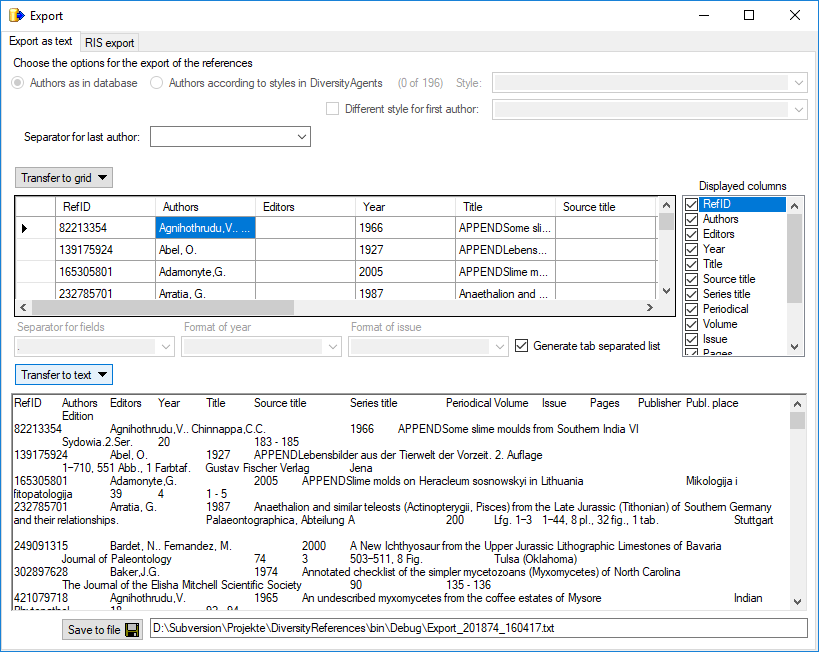
The second tab RIS Export provides the export of data in the RIS format according to the commercial database ReferenceManager use the RIS-Export function.

Click on the Start export button to generate the RIS tagged format
and on the Save 



 One parallel table
One parallel table Several parallel tables according to
selected data
Several parallel tables according to
selected data Dependent table
Dependent tableAll options will include the depending tables as defined for the default
table. The 
If you added parallel tables, you should set the sequence of the
datasets within these tables: For the columns that should be used for
sorting the data, set the ordering sequence to a value > 0 and choose
if the ordering sequence should be ascending 

 Certain columns in the database may provide information linked to
another table
Certain columns in the database may provide information linked to
another table 

 button
to add a linked value.
button
to add a linked value.




 on the left side of the column that will change to
on the left side of the column that will change to  for fused columns. To remove a file column, use the
for fused columns. To remove a file column, use the 




 This filter in contrast to the filter above strictly applies to the row
according to the sequence of the data. For an explanation see a short
tutorial
This filter in contrast to the filter above strictly applies to the row
according to the sequence of the data. For an explanation see a short
tutorial





If you want to inspect the SQL commands created during the test check this option. To see the generated SQL click on the SQL button after the Test export. A window containing all commands including their corresponding tables will be shown.






 To export your data into a SQLite
database, choose the
To export your data into a SQLite
database, choose the  Export to SQLite tab. You may change the preset name of the database in order to keep previous exports. Otherwise you overwrite previous exports with the same filename. To start the export, click on the Export data
Export to SQLite tab. You may change the preset name of the database in order to keep previous exports. Otherwise you overwrite previous exports with the same filename. To start the export, click on the Export data
 button. To view the exported data, use the
button. To view the exported data, use the










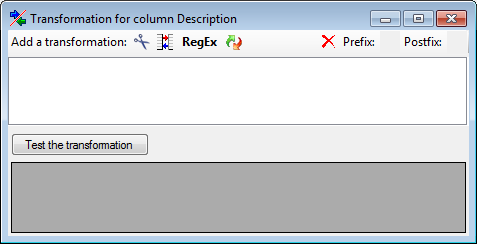
Here you can enter 6 types of transformation that should be applied to
your data. 




With the cut transformation 


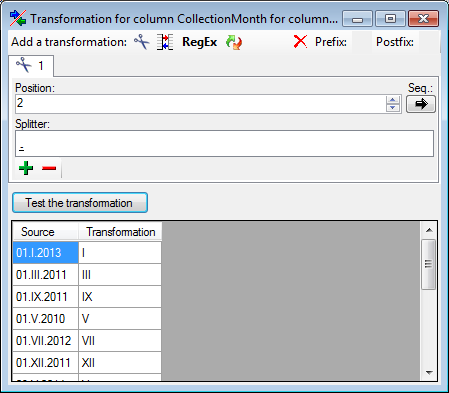
With the Start at Pos. option the given splitters will be converted into space (' ') and the whole string starting with the given position will be used (see below).

The translate transformation 






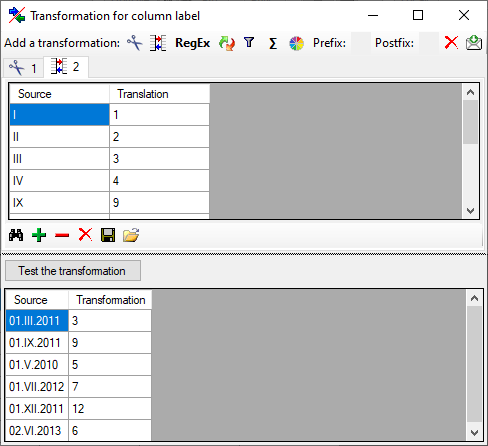
To load a predefined list for the transformation use the


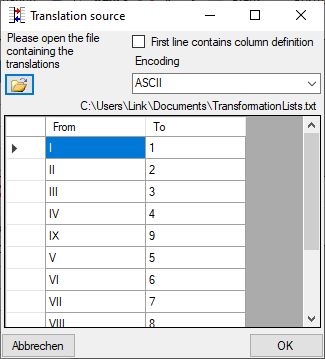
The transformation RegEx using regular expressions will transform the values according to the entered Regular expression and Replace by values. For more details please see documentations about regular expressions.

The replacement transformation 
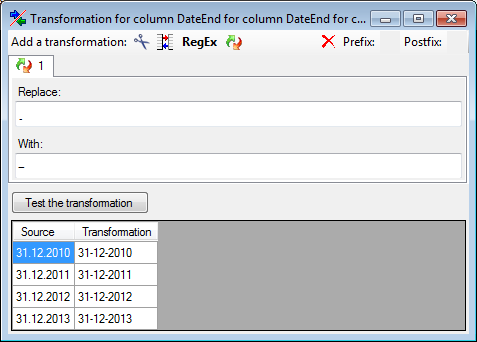
The calculation transformation Σ performs a calculation on numeric value, dependent on an optional condition. In the example below, 2 calculations were applied to convert 2-digit values into 4 digit years.
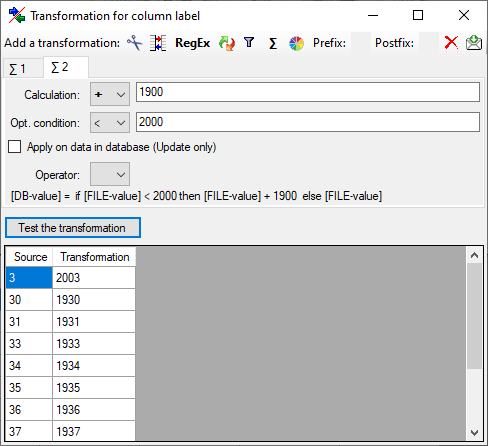
The filter transformation 






This tutorial demonstrates the export of a small sample from the
database. For an introduction see a short tutorial

In the main form, select the data that should be exported (only the data displayed in the query results are exported).
Choose Data → Export → 


In this example, we want to add as many parallel identification tables
as present in the data. To do this, click on the


To set the sequence of the Identifications, select the first table and
for the column IdentificationSequence set sorting sequence to 1 and the
direction for sorting to descending 
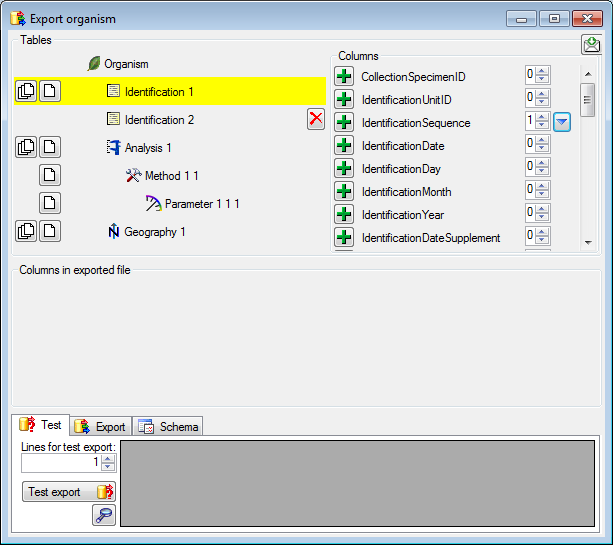
Some columns provide the possibility to add data from linked tables or modules. In this example we choose the column NameURI linking to the module DiversityTaxonNames (see below).

To provide linked values, click on the  button.
A window as shown below will open, where you can choose among the
provided services.
button.
A window as shown below will open, where you can choose among the
provided services.
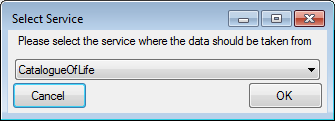
After the service is selected, you will be asked for the value provided by the service (see below).
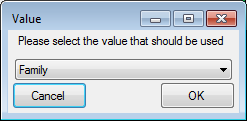
Now the selected link is added underneath the column as shown below. You can add as many links as you need for your export.

For some modules there are values that refer to other modules with a name like [Link to ...] as shown in the example below.

If you select one of theses values, you will be asked to select the service or database linked to this modul (see below)

... and then to select one of the provided columns (see below)

Within the form this linked values will be marked as shown below. If several results are retrieved these will be separated with by " | ".

To add columns to the exported file, click on the 

The families should appear as one column and as the sources can exist
only once for each identification we can fuse these columns. To do so,
click on the delimiters  between these
columns (see below).
between these
columns (see below).

By default the headers for the exported data are set according to the names of the columns in the database. To change this, edit them as shown below where TaxonomicName has been changed to Taxon (see below). For fused columns only the header in the first column will be used.

To test the export, click on the Test export


To finally export the data, choose the 



To import data stored in the commercial database Reference Manager use the RIS-Export function of Reference Manager.
Import
Choose Data → Import from the menu to start the import. A form will open where you can set the import options.
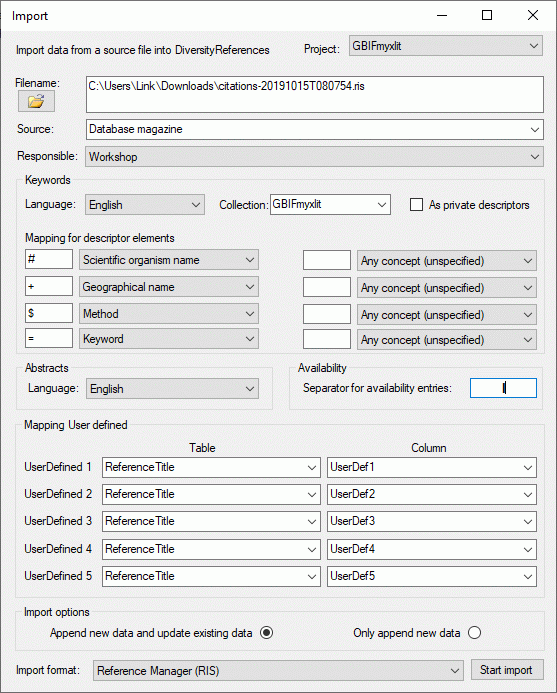
Filename: Click on the  button to choose the
file you want to import from your file system.
button to choose the
file you want to import from your file system.
Source: Specify the source of the data. This information will be documented in the [ImportedFrom] field in the table ReferenceTitle (see Import: in the main form) and used for subsequent imports and updates from the same source.
Responsible: The user who is responsible for the imported data.
Abstracts: Give the language of the abstracts in the references.
Availability: If more than one filing code is placed in one field, enter the separator for the filing codes.
Keywords: Give the language of the keywords in the references. The keywords can be transferred either to the private descriptors or the public available the descriptors. If you use special signs to classify you keywords you can use the mapping to translate this classification into the descriptor concept in DiversityReferences. This is shown in the [Mapping for descriptor elements] section in the image above.
Mapping User defined: The UserDefined fields within Reference Manager will be transferred to the corresponding fields within the table ReferenceTitle of DiversityReferences unless you specify it otherwise. If possible, use the more exact targets within DiversityReferences for your import.
Import options: You may either update data allready in the database and import new data from the source or just import new data.
Import format: Currently there is only one import format that is supported by DiversityReferences - Reference Manager (RIS).
Click the [Start import] button to start the import.
To import data stored in the commercial database Reference Manager use the RIS-Export function of Reference Manager.
Import
Choose Data → 


Filename: Click on the 
Responsible: Select the user who is responsible for the imported data.
Abstracts: Select the language of the abstracts in the references.
Availability: If more than one filing code is placed in one field, enter the separator for the filing codes.
Keywords: Select the language of the keywords in the references. The keywords can be transferred either to the private descriptors or the public available the descriptors. If you use special signs to classify you keywords you can use the mapping to translate this classification into the descriptor concept in DiversityReferences. This is shown in the Mapping for descriptor elements section in the image above.
Mapping User defined: The UserDefined fields within Reference Manager will be transferred to the corresponding fields within the table ReferenceTitle of DiversityReferences unless you specify it otherwise. If possible, use the more exact targets within DiversityReferences for your import.
Import options: You may either update data allready in the database and import new data from the source or just import new data.
Import format: Currently there is only one import format that is supported by DiversityReferences - Reference Manager (RIS).
Click the Start import button to start the import. You will be informed about import errors and the number of imported datasets by message windows. If any datasets have been imported, they will be displayed in the query list of the main window, when you close the import form (see image below).
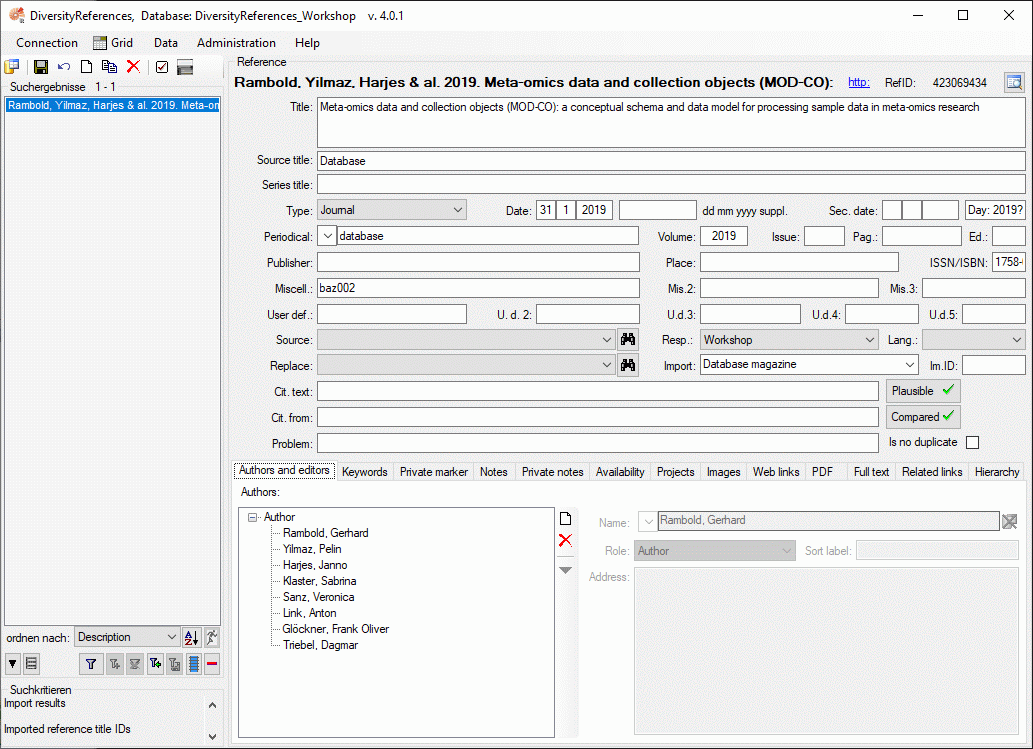
The import wizard is the general way to import data into a Diversity Workbench module database. It allows the import from tab separated text files (tsv) into the database tables. The key import steps, the definition of a mapping from tab seperated columns in the text file to the coresponding database table columns, is designed in the import wizard. As the mapping can be sometimes cumbersom to develop, the import wizard allows to save the mapping for repeated import of equaly structured tsv files.
The examples below are from the module 
With the current solution please ensure that there are no concurrent imports in the same database.
With this import routine, you can import data from text files (as
tab-separated lists) into the database. A short introduction is
provided in a video




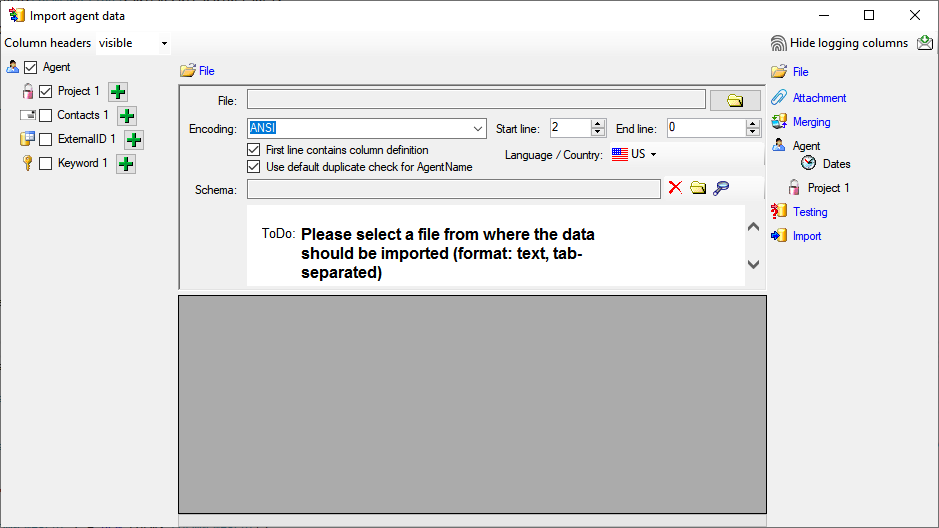
 File from where the data should be imported. The currently supported format is tab-separated text. Choosing a file will automatically set the default directory for the import files. To avoid setting this directory, deselect the option
File from where the data should be imported. The currently supported format is tab-separated text. Choosing a file will automatically set the default directory for the import files. To avoid setting this directory, deselect the option  Adapt default directory in the context menu of the button to open the file.
Adapt default directory in the context menu of the button to open the file.Starting with version 4.6 the default encoding changed to UTF8. Please use Windows for old ANSI encodings. The program will try to detect the encoding and warn you if it does not match the current encoding. The detection of the encoding depends on the presence of a BOM and does not work for every file, e.g. ANSI-encoding
 First line contains the column definition decides if this line will not be imported.
First line contains the column definition decides if this line will not be imported. Use the default duplicate check - see a video
Use the default duplicate check - see a video  for an explanation.
for an explanation. Translate \r\n to line break the character sequence \r\n in the data will be translated in a line break in the database.
Translate \r\n to line break the character sequence \r\n in the data will be translated in a line break in the database.
 Record all SQL statements.
Record all SQL statements. 

In the selection list on the left side of the window (see below) all possible import steps for the data are listed according to the type of data you want to import.
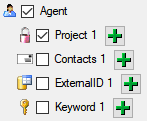
The import of certain tables can be paralleled. To add parallels click
on the 

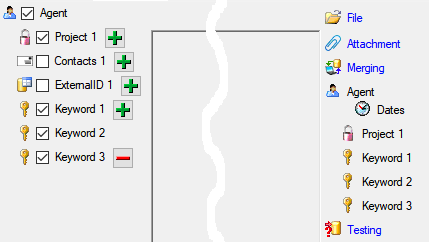
To import information of logging columns like who created and changed
the data, click on the  include logging columns button in the header line. This will include additional substeps for every step containing the
logging columns (see below). If you do not import these data, they will
be automatically filled by default values like the current time and
user.
include logging columns button in the header line. This will include additional substeps for every step containing the
logging columns (see below). If you do not import these data, they will
be automatically filled by default values like the current time and
user.

You can either import your data as new data or


Import as new data or one of the
columns the attachment columns offered like SeriesCode in the table
Series in the example below.

If you select a column for attachment, this column will be marked with a blue background (see below and chapter Table data).

You can either import your data as new data or  Merge them with data in the
database. Select the import step
Merge them with data in the
database. Select the import step  Merge from the list. For
every table you can choose between
Merge from the list. For
every table you can choose between 



The 
The 

The 

The 


Empty content will be ignored e.g. for the 

To set the source for the columns in the file, select the step of a
table listed underneath the  Merge step. All
columns available for importing data will be listed in the central part
of the window. In the example shown below, the first column is used to
attach the new data to data in the database.
Merge step. All
columns available for importing data will be listed in the central part
of the window. In the example shown below, the first column is used to
attach the new data to data in the database.

A reminder in the header line will show you which actions are still needed to import the data into the table:
 = No
column has been selected so far.
= No
column has been selected so far. = If data will be imported depends on the content of decisive
columns, so at least one must be selected.
= If data will be imported depends on the content of decisive
columns, so at least one must be selected. =
The position in the file must be given if the data for a column
should be taken from the file.
=
The position in the file must be given if the data for a column
should be taken from the file. = For all merge types other than insert columns
for comparison with data in the database are needed.
= For all merge types other than insert columns
for comparison with data in the database are needed. = You have
to select a value from the provided list
= You have
to select a value from the provided list = You have to enter
a value used for all datasets
= You have to enter
a value used for all datasetsThe handling of the columns in described in the chapter columns.
 - To test if all requirements for the import are met use the
- To test if all requirements for the import are met use the
 Testing step. You can use a certain line in
the file for your test and then click on the Test data in line: button. If there are still
unmet requirements, these will be listed in a window as shown below.
Testing step. You can use a certain line in
the file for your test and then click on the Test data in line: button. If there are still
unmet requirements, these will be listed in a window as shown below.
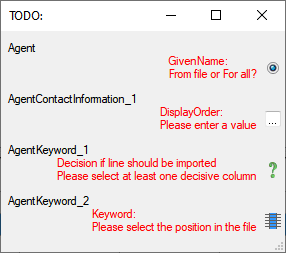
If finally all requirements are met, the testing function will try to write the data into the database and display any errors that occurred as shown below. All datasets marked with a red background, produced some error.

To see the list of all errors, double click in the error list window in the header line (see below).

If finally no errors are left, your data are ready for import. The colors in the table nodes in the tree indicate the handling of the datasets:
The colors of the table columns indicate whether a column is decisive



If you suspect, that the import file contains data already present in
the database, you may test this and extract only the missing lines in a
new file. Choose the attachment column (see chapter Attaching data) and
click on the button Check for already present data. The data already
present in the database will be marked red
(see below). Click on the button
Save missing data as text file 


If you happen to get a file with a content as shown below, you may have seleted the wrong encoding or the encoding is incompatible. Please try to save the original file as UTF8 and select this encoding for the import.
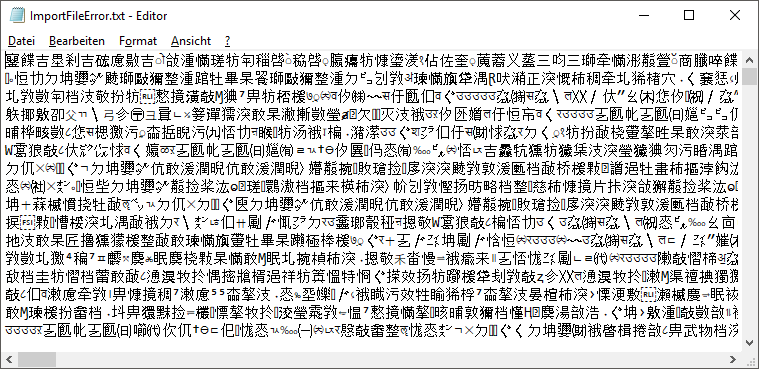


Schedule for import of tab-separated text files into DiversityAgents
Lines that could not be imported will be marked with a red background while imported lines are marked green (see below).
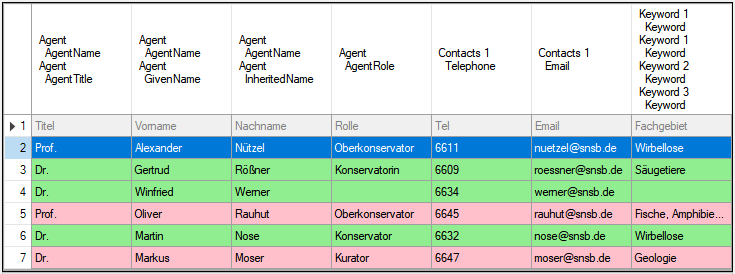
If you want to save lines that produce errors during the import in a separate file, use the Save failed lines option. The protocol of the import will contain all settings according to the used schema and an overview containing the number of inserted, updated, unchanged and failed lines (see below).
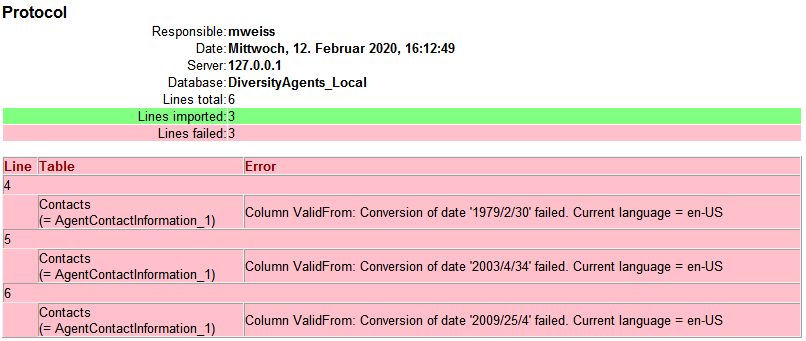


If you store your reference related data in commercial software like Reference Manager, you can export your data using the export functionality provided by this software. The description below referes to an older verion of Reference Manager, but should be available in a similar form in current versions as well.
To export data from Reference Manager use the RIS-Format as shown below.
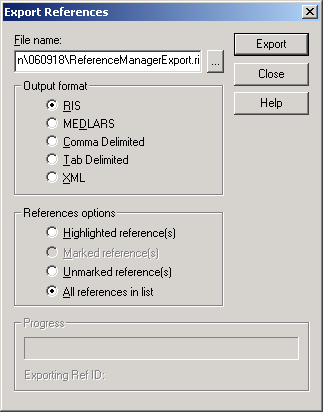
To import these data in DiversityReferences you first have to convert the exported data to UNICODE. To do this you may use Microsoft Word as described below.
In MS-Word set check the confirm conversion option as shown below.
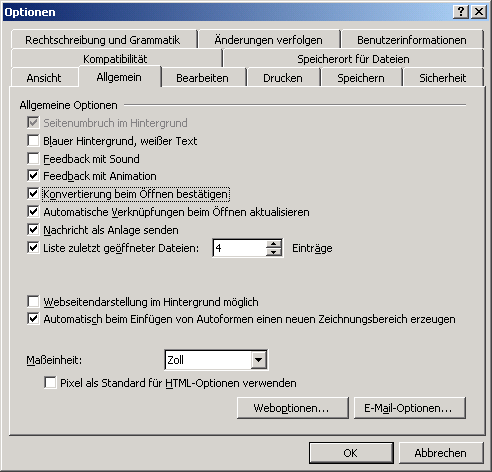
When MS-Word opens the file exported by Reference Manager choose coded text as shown below.
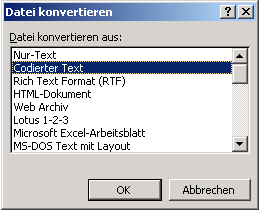
In the next menu choose MS-DOS as the coding used by Reference Manager

Then save the file as Unicode (UTF-8)

This file is than ready for import into DiversityReferences.
Overview for the RIS-Format Tag in Reference Manager export files and mapping to DiversityReferences.
| Tag | Description | Table | Column |
| A1 | Author Primary. Each author must be on a | ReferenceRelator | Name |
| A2 | Author Secondary. Each author must be on a separate line, | ReferenceRelator | Name |
| A3 | Author Series. Each author must be on a separate line, preceded by this tag. Each reference can unlimited author fields. The author name must be in the correct syntax (refer to A1 and AU fields). Each author name can be up to 255 characters long. | ReferenceRelator | Name |
| AB | alphanumeric characters; there is no practical length limit to this field. Reference Manager User’s Guide 361 | ReferencePrivateNotes | Content |
| AD | Address. This is a free text field and contain alphanumeric characters; there is no practical length limit to this field. | ReferenceRelator | Address |
| AU | separate line, preceded by this tag. Each reference can contain unlimited author fields, and can contain up to 255 characters for each field. separate line, preceded by this tag. Each reference can contain unlimited author fields, and can contain up to 255 characters for each field. | ReferenceRelator | Name |
| AV | Availability. This field can contain alphanumeric characters. There is no practical length limit to this field. | ReferenceAvailability | FilingCode |
| BT | for all reference types except for Whole Book and Unpublished Work references. This field can contain alphanumeric characters; there is no | ReferenceTitle | Title |
| CP | length limit to this field. | ReferenceTitle | PublPlace |
| CT | Unpublished Work references. This | ReferenceTitle | Title |
| CY | City of publication; this is an alphanumeric field; there is no practical length limit to this field. | ReferenceTitle | PublPlace |
| ED | preceded by this tag. Each reference can contain unlimited author fields. The author name must be in the correct syntax (refer to A1 and AU fields). This author name can be up to 255 characters long. | ReferenceRelator | Name |
| EP | Ending page number, as above. | ReferenceTitle | Pages |
| ER | End of reference. Must be the last tag in a reference. | < end tag > | |
| ID | Reference ID. (Note that any information in this field is not imported.) | ReferenceTitle | ImportedID |
| IS | Issue. This is an alphanumeric field, there is no practical | ReferenceTitle | Issue |
| J1 | Periodical name: user abbreviation 1. This is an alphanumeric field of up to 255 characters. | ReferencePeriodicalSyn | Synonym |
| J2 | Periodical name: user abbreviation 2. This is an alphanumeric field of up to 255 characters. | ReferencePeriodicalSyn | Synonym |
| JA | periodical in which the article was (or is to be, in the case of in-press references) published. This is an alphanumeric field of up to 255 characters. If possible, periodical names should be abbreviated in the Index Medicus style, with periods after the periodical in which the article was (or is to be, in the case of in-press references) published. This is an alphanumeric field of up to 255 characters. If possible, periodical names should be abbreviated in the Index Medicus style, with periods after the | ReferenceTitle | Abbreviation |
| JF | Periodical name: full format. This is an alphanumeric field of up to 255 characters. | ReferencePeriodical | FullName |
| JO | Periodical name: standard abbreviation. This is the 362 Appendix C—RIS Format Specifications | ReferencePeriodical | Abbreviation |
| KW | Keywords. Each keyword or phrase must be on its own line, preceded by this tag. A keyword can consist of multiple words (phrases) and can be up to 255 characters long. There can unlimited keywords in a reference. | ReferenceDescriptor | Content |
| L1 | Link to PDF. There is no practical length limit to this field. URL addresses can be entered individually, one per tag or multiple addresses can be entered on one line using a semi-colon as a separator. | ReferenceTitle | LinkToPDF |
| L2 | Link to Full-text. There is no practical length limit to this field. URL addresses can be entered Reference Manager User’s Guide 365 individually, one per tag or multiple addresses can be entered on one line using a semi-colon as a separator. | ReferenceTitle | LinkToFullText |
| L3 | Related Records. There is no practical length limit to this field. | ReferenceTitle | RelatedLinks |
| L4 | Images. There is no practical length limit to this field. | ReferenceTitle | LinkToImages |
| M1 | Miscellaneous 1. This field can contain alphanumeric characters.There is no practical length limit to this field. | ReferenceTitle | Miscellaneous1 |
| M2 | Miscellaneous 2. This field can contain alphanumeric characters.There is no practical length limit to this field. | ReferenceTitle | Miscellaneous2 |
| M3 | Miscellaneous 3. This field can contain alphanumeric characters. There is no practical length limit to this field. | ReferenceTitle | Miscellaneous3 |
| N1 | Notes. These are free text fields and can contain | ReferencePrivateNotes | Content |
| N2 | Abstract. This is a free text field and can contain alphanumeric characters; there is no practical length limit to this field. | ReferenceNote | Content |
| PB | Publisher; this is an alphanumeric field; there is no practical length limit to this field. | ReferenceTitle | Publisher |
| PY | following format: | ReferenceTitle | DateYear |
| RP | Reprint status. This optional field can contain one of three status notes. Each must be in uppercase, and the date after “ON REQUEST” must be in USA format, in parentheses: (MM/DD/YY). If this field is blank in your downloaded text file, the Import functi | ReferenceAvailability | ReprintStatus |
| SN | ISSN/ISBN. This field can contain alphanumeric characters. There is no practical length limit to this field. | ReferenceTitle | ISSN_ISBN |
| SP | Start page number; an alphanumeric string, there is | ReferenceTitle | Pages |
| T1 | Title Primary. Note that the BT tag maps to | ReferenceTitle | Title |
| T2 | Title Secondary. Note that the BT tag maps to this field | ReferenceTitle | SourceTitle |
| T3 | Title Series. This field can contain alphanumeric characters; there is no practical length limit to this field. | ReferenceTitle | SeriesTitle |
| TI | This field only for Whole Book and | ReferenceTitle | Title |
| TY | Type of reference. This must contain one of the field names as defined in the following section, “Reference Type field names.” | ReferenceTitle | RefType |
| U1 | User definable 1. This is an alphanumeric field; there is no practical length limit to this field. | ReferenceTitle | UserDef1 |
| U2 | User definable 2. This is an alphanumeric field; there is no practical length limit to this field. | ReferenceTitle | UserDef2 |
| U3 | User definable 3. This is an alphanumeric field ; there is no practical length limit to this field. | ReferenceTitle | UserDef3 |
| U4 | User definable 4. This is an alphanumeric field, there is no practical length limit to this field. | ReferenceTitle | UserDef4 |
| U5 | User definable 5. This is an alphanumeric field; there is no practical length limit to this field. | ReferenceTitle | UserDef5 |
| UR | Web/URL. There is no practical length limit to this field. URL addresses can be entered individually, one per tag or multiple addresses can be entered on one line using a semi-colon as a separator. | ReferenceTitle | WebLinks |
| VL | Volume number. This is an optional field, there is no practical length limit to this field. | ReferenceTitle | Volume |
| Y1 | Date Primary. This date must be in the | ReferenceTitle | DateYear |
| Y2 | Date Secondary. (Refer to Y1 and PY fields). | ReferenceTitle | DateYear2 |